[Editor’s Note: During this unprecedented period of enforced isolation and telework, Mad Scientist solicited your input on how the current COVID-19 Global Pandemic could shape the Operational Environment (OE) and change the character of warfare. During the coming weeks (or, Heaven help us, months!), Mad Scientist Laboratory will present the most compelling insights received in our “Contagion” series of blog posts. We are pleased to launch “Contagion” with today’s post by Chris Elles, who provides a number of perceptive observations for consideration — Read on!]
New Zealander Chris Elles responded to several queries from the Mad Scientist Initiative’s How Will the COVID-19 Global Pandemic Shape the Operational Environment? writing prompts with the following insights and conclusions:
-
- How will the pandemic affect Russia and China, our current and emergent pacing threats?
OPEC’s complete loss of cartel pricing control for the foreseeable future, in the wake of declining energy demand due to COVID-19, has serious ramifications for Russia.
Approximately two thirds of Russia’s exports and half of total the Russian government revenue are dependent on collapsing energy prices.

It’s worth remembering the 1980’s Oil Glut and how the associated low energy prices played a significant contributing factor to the collapse of the Soviet Union.
While it is highly unlikely we will see a repeat of the 1991 Soviet collapse in today’s Russia, a most likely course of action for Vladimir Putin’s regime may include activities that are even further along the conflict continuum, away from conventional and towards unconventional action. 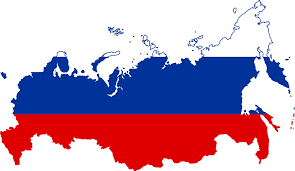 This is due to Russia’s declining fiscal capacity to support conventional kinetic options combined with Russia’s recent success with, and the relative affordability of, asymmetric unconventional options to achieve foreign policy objectives.
This is due to Russia’s declining fiscal capacity to support conventional kinetic options combined with Russia’s recent success with, and the relative affordability of, asymmetric unconventional options to achieve foreign policy objectives.
It would not be unexpected to see Russia’s near term foreign policy objectives designed to lift energy prices.
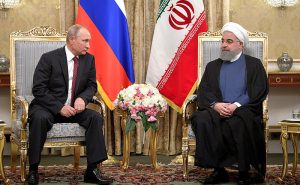
Iran’s interests are almost identically aligned with Russia, at least with this specific slice of fiscal and foreign policy.
Russian and Iranian activities to disrupt energy export competitors to accelerate market prices is likely to be a primary line of effort.
China’s recovery from COVID-19 will require the Chinese Communist Party / People’s Liberation Army (CCP/PLA) to place increased proportional emphasis on domestic economic stabilisation in the short-term, with low energy prices providing Chinese energy consumption an economic recovery tailwind.
China is likely to proportionally increase focus and effort inwards on its domestic recovery in the short term to conservatively guarantee CCP/PLA continuity. However, the greater the severity and longevity of economic disruption suffered, the greater risk of a hybrid Falklands/Grenada scenario with Chinese characteristics.
 External distraction away from growing domestic crisis, akin to action by the Argentine junta in 1982, is an ever present option for China’s CCP/PLA — activating a nationalistic population that has not experienced foreign military adventure in two generations (i.e., the Sino-Vietnamese War of 1979). However, CCP/PLA conservatism in executing a near shore external operation would demand a similar result to the US intervention in Grenada.
External distraction away from growing domestic crisis, akin to action by the Argentine junta in 1982, is an ever present option for China’s CCP/PLA — activating a nationalistic population that has not experienced foreign military adventure in two generations (i.e., the Sino-Vietnamese War of 1979). However, CCP/PLA conservatism in executing a near shore external operation would demand a similar result to the US intervention in Grenada.
The Chinese characteristics of a near shore hybrid Falklands/Grenada-like action to distract its population away from the potential for domestic crisis would likely include: absolute certainty of outcome, experimentation with recently introduced PLA platforms and doctrine, a clear signal of China as a rising global challenger, and it being quickly conducted to preclude disruption to global markets.
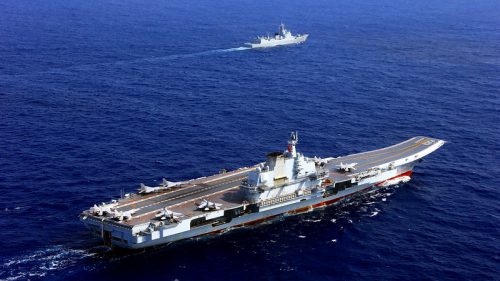
However, China’s need for cheap energy imports from Russia and Iran to accelerate and fuel its COVID-19 recovery means China’s interests will be incongruent on energy policy with Russia’s and Iran’s interests as long as exceptionally low energy prices remain intensely painful for these high cost producers.
Exceptionally low energy prices will have grave and potentially existential consequences for nations dependent on energy exports. Energy exporting nations with the highest marginal production cost may be most vulnerable to disruption by external actors applying unconventional means.
But how can that foreign policy incongruence be leveraged between and amongst challenger (China), disruptor (Russia & Iran) and energy producer states to the advantage of the US and its coalition partners?
-
- How will nations react to China’s Belt and Road Initiatives in light of these events?
Too soon to tell?
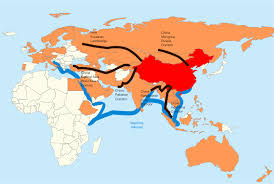
Last year I wrote a Mad Scientist semi-finalist fictional story that incorporated the potential for China to aggressively export its largely domestic digital super platforms into its One Belt, One Road initiative in the near future.
Despite recent delays, Chinese efforts to deploy a Digital Yuan continue, while Facebook Libra is stillborn.
Most COVID-19 focus has been on China and the West and how we will all respond, reset, and recover — including the potential for new financial habits, behaviours, and norms.
The same will occur in the developing world and it is here where we must carefully monitor and respond to the potential for the Digital Yuan to be exported and injected.
Perhaps the needle moves towards Geodigital with the potential application of Moore’s Law to the Geopolitical arena.
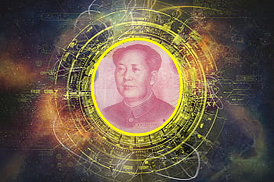 What happens if China exploits an opportunity to export a digital triad, represented by super platforms like WeChat, surveillance tech running in the background shared with local nation government “moderators” accepting of Chinese “admins,” with platform transaction value shifting regional trade from U.S. Dollars to Digital Yuan?
What happens if China exploits an opportunity to export a digital triad, represented by super platforms like WeChat, surveillance tech running in the background shared with local nation government “moderators” accepting of Chinese “admins,” with platform transaction value shifting regional trade from U.S. Dollars to Digital Yuan?
-
- What are the collective impacts this pandemic will have on globalization versus nationalism, and how will supply chains evolve?
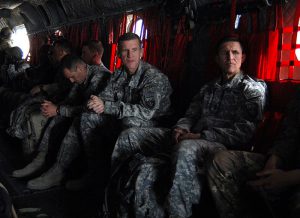
GEN Stan McChrystal’s book Team of Teams is well worth revisiting here. McChrystal posits that in a world of fast rising complexity, predictability is in steep decline. In an increasingly complex and unpredictable environment laid out by McChrystal, our global supply chains built on the singular pursuit of efficiency are at great risk of disruption from outlier events, such as COVID-19.
Globalisation is not over, but future global supply chains will likely bifurcate into national-strategic and non-essential.
We already possess national-strategic stockpiles of commodities, but in the wake of COVID-19, it is highly likely that we will redesign the architecture of manufacturing supply chain capability and senior national leadership will redesignate key lines as national-strategic.
We will likely shift from a capacity (national-strategic commodity stockpile) focus to include more capability (localised manufacturing supply chain for national-strategic homefront footprint) focus.
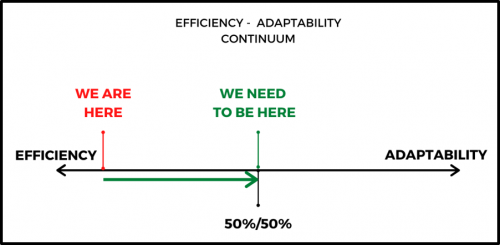
- Was this a Black Swan or Pink Flamingo event, and what lessons regarding national resiliency can we learn to help mitigate future global crises?

I’m a big fan of Michele Wucker’s concept of “obvious but ignored” Grey Rhino events.
In a Stanford Graduate School of Business political economics class back in 2016, we learned voters were far more likely to reward disaster relief than disaster preparedness. Senior national leadership face a considerable disincentive from investing in disaster preparation.
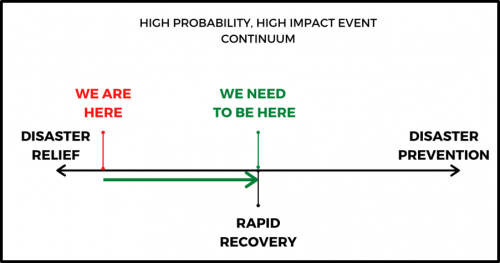
So in light of the headwind that disaster preparation investment represents to our senior national leadership, we have an opportunity to attack the problem from a different angle and develop policy with low political cost to leadership to shape supply chain adaptability for all redesignated national-strategic supply chain capability.
The more we move along the continuum away from a singular focus on efficiency and towards adaptability, the more we concurrently move along the continuum from relief towards prevention, meeting in the middle at rapid recovery.
If you enjoyed this post, please also see:
 Chris Elles is a Sergeant in the Royal New Zealand Infantry Regiment (Reserve) who has developed and delivered innovation training packages for both the New Zealand and Australian Defence Forces while serving as Phase Manager for the NZ Army Aumangea Assessment Programme. Chris is an entrepreneur, startup mentor, and angel investor. As an early stage employee, he was responsible for the physical launch beyond books for Amazon.com. He is an alumnus of Stanford University Graduate School of Business and completed Hacking 4 Defense Educator Certification at Georgetown University. Chris is curating the Innovator Handbook Mk I: A Handbook For Small Team Military Innovation. He can be found on Twitter @InnovatorHB
Chris Elles is a Sergeant in the Royal New Zealand Infantry Regiment (Reserve) who has developed and delivered innovation training packages for both the New Zealand and Australian Defence Forces while serving as Phase Manager for the NZ Army Aumangea Assessment Programme. Chris is an entrepreneur, startup mentor, and angel investor. As an early stage employee, he was responsible for the physical launch beyond books for Amazon.com. He is an alumnus of Stanford University Graduate School of Business and completed Hacking 4 Defense Educator Certification at Georgetown University. Chris is curating the Innovator Handbook Mk I: A Handbook For Small Team Military Innovation. He can be found on Twitter @InnovatorHB
Disclaimer: The views expressed in this blog post do not necessarily reflect those of the Department of Defense, Department of the Army, Army Futures Command (AFC), or the Training and Doctrine Command (TRADOC).




Very succinct layout; however, I see a point of contention related to “…In a Stanford Graduate School of Business political economics class back in 2016, we learned voters were far more likely to reward disaster relief than disaster preparedness. Senior national leadership face a considerable disincentive from investing in disaster preparation.”
Problem here is that approach, as we’ve seen, is now no longer true; despite the media services misinformation and outright disinformation from Mayor’s, Governors, and disgruntled (and fired due to bloat) federal appointees about preparedness. Studies and recommendations (2005 Pandemic strategy https://www.cdc.gov/flu/pandemic-resources/pdf/pandemic-influenza-strategy-2005.pdf), post-2009 swine flu and 2014 ebola recommendation studies to replenish the national stockpile (see: https://www.usatoday.com/story/news/factcheck/2020/04/03/fact-check-did-obama-administration-deplete-n-95-mask-stockpile/5114319002/) (it was ignored) and cities actually ran table top exercises on the effects of a pandemic (NYC in 2015 – https://www.nbcnewyork.com/news/coronavirus/new-york-modeled-a-pandemic-and-found-a-15000-ventilator-shortfall/2331046/). Now we have finger pointing and “who’s to blame?” diversions from the real culprits.
So the “what you need to do” aspects are there, yet ignored because the “we responded” aspect is what people like. Politicians need to articulate to the citizens that to be able to respond you need something to respond with–along with explaining who can and can’t respond and how/why (e.g., the federal government can’t just show up, they have to be asked by a governor. During Hurricane Katrina the governor of Louisiana failed to ask for timely federal assistance and when she finally did, the complaints were “why did it take so long!!!” when it the aspect of federal overreach means the federal government simply can’t show up without being asked and once asked, federal aid simply doesn’t materialize overnight.
Prioritizing resources to ensure that should something happen you’ve actually got what you need to respond. Taking resources that aren’t at the right level from one part of a state to focus on another part of a state, and using the National Guard to enforce it, is robbing Peter to pay Peter (see: https://news.wbfo.org/post/governors-ventilator-order-not-sitting-well-wny-lawmakers-hospital-leaders) and the second order effects of National Guard troops taking needed resources potentially from their own family members was not considered. Mayors, Governors, etc. have to inform their constituents before a crisis why funds need to go to preparation; otherwise, we have what we have now–not enough.